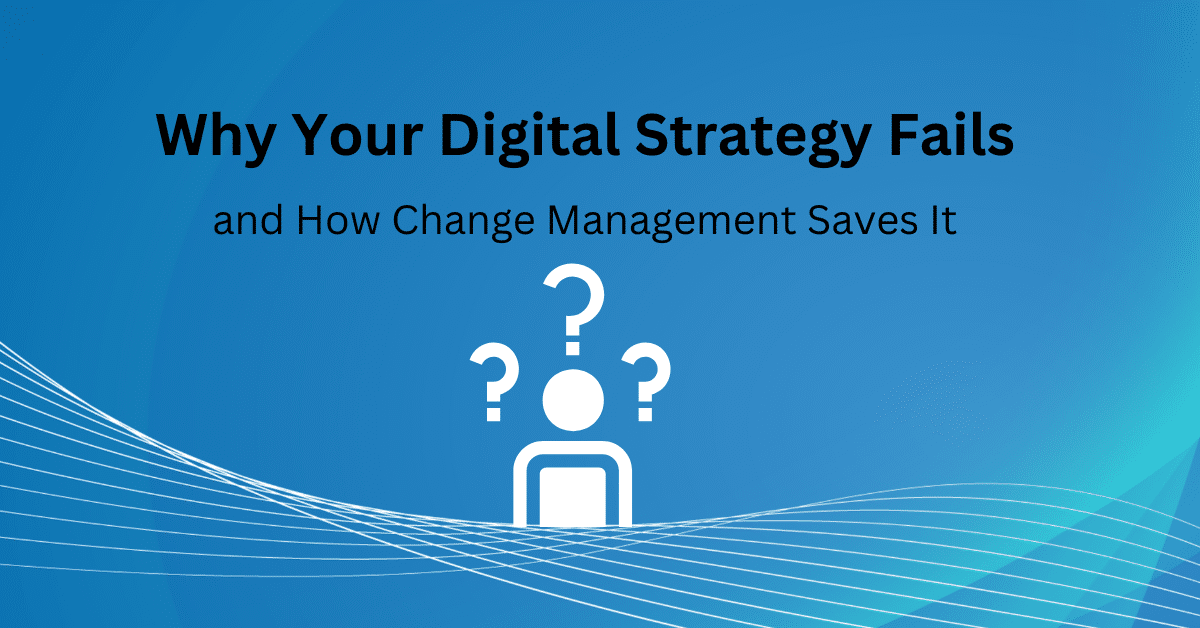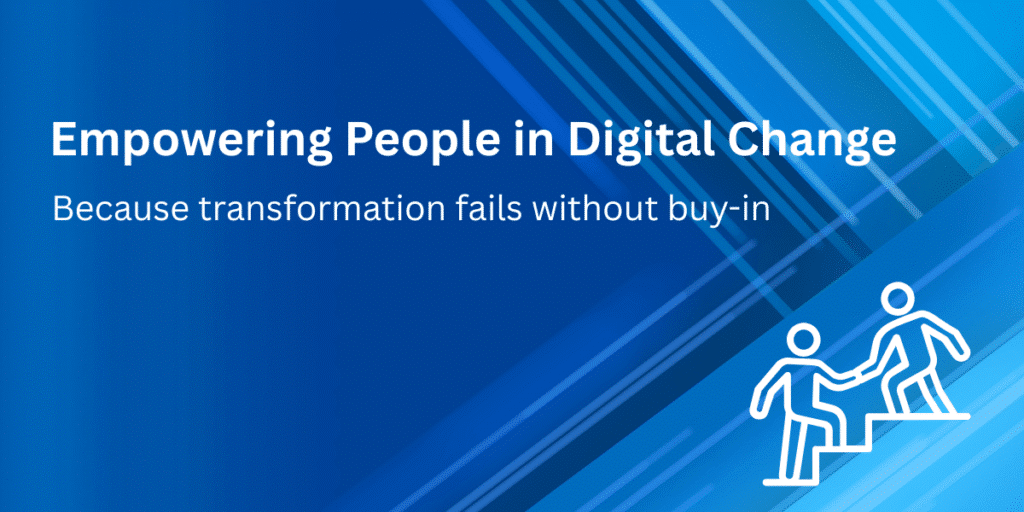
The Real Reason Your Digital Strategy Fails
Your Digital Strategy Will Fail Without This One Element
Your digital transformation will fail—and it won’t be because of bad tech.
Many companies assume that digital strategy means selecting the right tools, platforms, or partners. They invest in CRMs, cloud platforms, dashboards, or ERP integrations. Then reality hits—adoption stalls, teams push back, and key performance indicators stay flat. Why? Because they’ve missed the critical piece that makes everything else work: change management. Without it, your digital strategy cannot succeed.
That’s the real reason your digital strategy fails – you leave your people behind.
Key Takeaways of this Article
- Digital tools alone don’t drive results; people and processes must evolve too.
- Change management is crucial for avoiding resistance, delays, and failed implementations.
- Practical strategies help embed change into company culture.
- SMEs can adopt lightweight, practical change management approaches without huge budgets.
What Is: Why Digital Strategy Alone Isn’t Enough
You’ve mapped out a digital roadmap. You’ve shortlisted vendors. Maybe you’ve even started pilot projects. But the results feel underwhelming.
Digital transformation without change management creates friction. Staff nod in meetings but ignore the new system. Managers quietly revert to Excel. The project stalls. Sound familiar?
Employees struggle to understand why they need to adapt to new changes. Middle managers protect old workflows. Leaders underestimate the time and communication required to shift behaviours.
Transformation initiatives often fail due to people-related issues, not technical issues. Tools don’t change culture. People do.
That’s the current state: well-intentioned digital investments that miss the mark because they treat transformation as a project, not a people-centred journey.
Consider a digital CRM rollout. If your sales team doesn’t understand why the system matters or views it as extra administrative work, they won’t use it properly, regardless of how advanced it is. The same goes for finance software, HR automation, or project tracking tools. The technology might be cutting-edge, but without buy-in, it’s just shelfware.
Change Management in Your Digital Strategy: A Strategic Lever
Now, imagine digital transformation as a guided process—where communication aligns with execution, and people understand the ‘why’ before the ‘how’.
Change management provides this structure. It helps leaders:
- Set a clear vision and narrative
- Identify internal champions and resistance points
- Tailor communication to stakeholders
- Offer training and support as part of the rollout
This doesn’t require a new department or a large team. It demands clarity, consistency, and commitment. Companies that don’t do this see digital tools collect dust.
Successful change management also builds resilience. Teams become more adaptable and confident in facing future changes. Over time, this creates a culture of learning and improvement, key ingredients for innovation and growth.
The Key Components of SME-Friendly Change Management
- Define a Human-Centred Narrative
Avoid tech jargon. Focus on how new tools make work easier or growth more achievable. Make the story relatable. Link digital efforts to pain points your teams already experience. - Map the Stakeholders Early
Identify champions within departments who can explain the change in their own words. Also, understand who has influence, not just who has authority. Resistance often comes from informal leaders. - Start with a Small Success
Success stories create momentum. For example, automate a manual reporting task and demonstrate the time it saves. Then let that team share their win across departments. - Embed Feedback Loops
Regular check-ins, suggestion boxes, or digital surveys can surface pain points early. Actionable feedback shows respect and fosters trust. - Celebrate Adoption, Not Just Launch
Recognise those who model new behaviours. Showcase teams that improve customer turnaround or reduce errors using the new system. - Train Beyond the Tool
Create scenario-based workshops that simulate real daily use, not just software tutorials. Help teams see how their roles evolve and how to respond confidently. - Create Accountability Mechanisms
Include adoption metrics in performance reviews. Create department scoreboards that visualise how different teams are progressing. - Provide Leadership Visibility
Ensure that top management discusses the change openly. Internal newsletters, team huddles, or video messages help frame the change as a company-wide mission.
A Singapore SME Example: What Success Looks Like
A private medical clinic in Singapore implemented a new patient management system to streamline bookings, records, and billing. The technology worked fine, but staff initially felt overwhelmed and resistant. The clinic’s management responded by holding short feedback sessions, involving nurses and administrative staff in decision-making, and adjusting workflows based on input. Within three months, appointment scheduling improved by 40%, and patient wait times dropped significantly.
Their success wasn’t due solely to the software. It came from giving people space to adapt, question, and improve.
Another Real-World Insight: Manufacturing SME Perspective
A mid-sized manufacturing firm in Johor introduced a digital inventory platform to reduce stock errors. The project initially struggled—floor staff found the interface confusing and failed to update stock records. The firm paused, surveyed its team, and discovered that many didn’t understand why real-time data mattered.
After workshops explained how digital accuracy affected costs and delivery timelines, and after they redesigned data entry screens with user input, adoption surged. The company not only met its stock accuracy goals, but it also halved its inventory reconciliation time within six months.
Final Thoughts: Make Change Management a Default, Not an Afterthought
Still think you can roll out software without preparing your people? Think again.
Don’t wait for adoption issues to appear. Bake change management into your digital strategy from day one. It’s not an add-on; it’s the bridge between planning and success.
If you’re leading digital initiatives in an SME or mid-sized business, your people are your biggest asset—and your most significant risk. Equip them properly.
Digital transformation is not about technology replacing people. It’s about technology enabling people to work better, smarter, and with more purpose. That shift doesn’t happen automatically. It requires leadership, and that’s where change management earns its place.
You don’t need a big budget to do this. You need a clear plan, consistent communication, and a willingness to listen. If your strategy starts with people, your tools will follow.
CTA: Digital chaos is optional. Please book a consultation and start leading change, not chasing it.
Hybrid Analytica supports SME leaders in Singapore and Southeast Asia with digital strategies that work, because we start with people, not just platforms.
Contact Us
FAQ
What is change management in digital transformation?
It’s the structured approach to help people adopt new behaviours, tools, and mindsets during transformation.
Is change management only for large companies?
No. SMEs benefit even more, as smaller teams feel the impact of change more quickly and directly. It’s often more agile as well.
What if I have already launched digital tools? Is it too late?
Not at all. You can apply change strategies even after implementation to boost adoption and performance. Many successful projects course-correct after rollout.
How much does change management cost?
It varies, but many approaches rely on better planning, communication, and internal leadership, rather than external spending. Even simple feedback loops and clear internal messaging can make a big difference.
Can Hybrid Analytica help with this?
Yes. We design transformation programmes that integrate change support, tailored to your team’s needs and size. Our goal is to help you align people, process, and platforms—without the friction.






